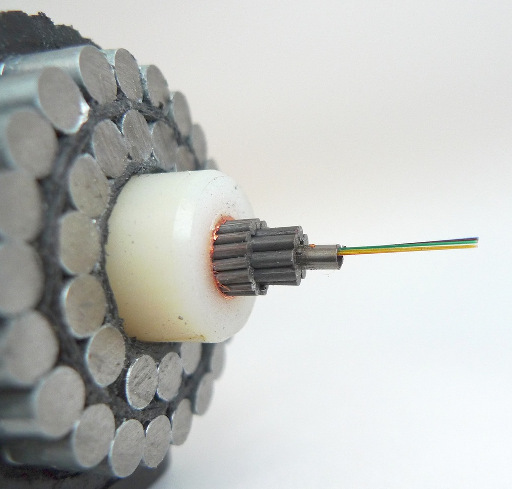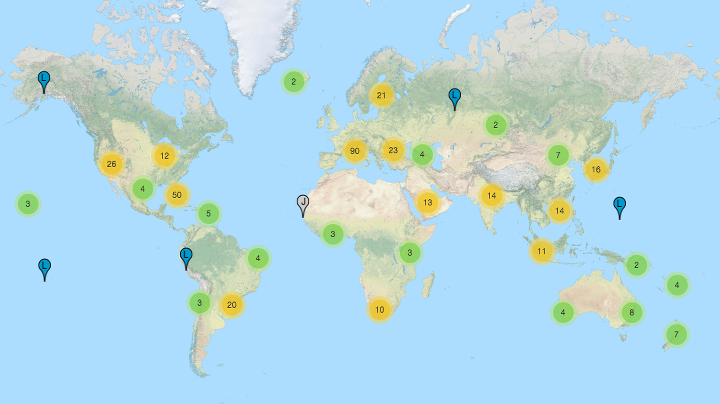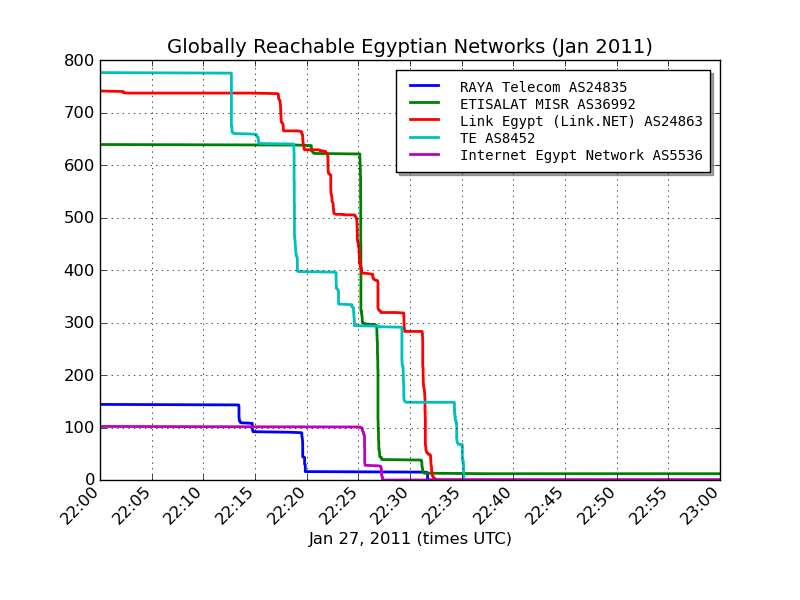Is it possible to "break" the Internet?
Technological progress over the last century has led to an interesting paradox: people cannot imagine their life without the existence of which they could not even imagine 30-40 years ago. In the field of information, it was once a radio, television came after it, and then the Internet arrived. Yes, it came in so tightly that little children were no longer put in a corner, they just turned off the Internet. And my 60-year-old mother regularly watches weather forecasts, news, and dog care videos on YouTube on the tablet.
We all take the Internet for granted, and when it disappears for a while, we are outraged like a driver who was whipped off at the whitish daughter on a pink jeep at speed. But can something lead to a global disruption of the work of this entire web, at the sight of which any spider would probably have broken its mind?

')
According to some information, this is exactly what the modern Internet map looks like. Initially, the network was conceived as decentralized and flexibly routable. In case of breaking one connection, the data will go around, on the other. Looking at the map, it is difficult to imagine at what points to strike, so that everything stops working. But let's still fantasize a little bit about what actions, processes and events, artificial and natural, could seriously disrupt the work of this complex organism (not forgetting that not all of this is such a fantasy).
No, this is not advice for girls whose guys are firmly seated in the games of the genre MMORPG. Today, about 99% of the traffic is transmitted over cable networks, from a twisted pair cable that extends into a porch, to such deep-sea and oceanic main trunk cables.

At the beginning of 2014, there were 285 underwater highways. All of them are carefully marked on a publicly available map . The exact locations of some of them on land are not known, some gently prikopany from prying eyes, while others can be found on such obvious announcements:

Damage to one or more cables will not lead to a complete collapse, only add brakes to some resources. The total bandwidth of the channels, based on the extrapolation of data from previous years, should be from about 1Tbps for Africa to almost 100Tbps for Europe. In this case, the use of channels is about 50-75%. Damage to one cable is easily compensated by the free capacity of the rest. In order to completely separate the continents, a certain international terrorist Mahmud Ivanovich van Johnson-Rabinovich Ji will have to spend a lot of resources to find all exit points, dig out the cables and at the same time damage them. And it is also desirable not to allow repair crews, which immediately rush to fix the problem, to damage sites as long as possible. Anyway, it will not completely destroy the network, it will only break it into continental segments, each of which will continue to exist autonomously.
The domain name system was created primarily for human convenience. habrahabr.ru remembering is easier than 212.24.44.141 and 212.24.44.133. Information about all domains of the most popular domain zones (com, net, org) is contained on the root servers. There are 13 of them, they are called Latin letters from A to M. Hypothetically, if they are somehow disabled, after clearing the providers caches, domain names will no longer be resolved, and although the network will work, users will not be able to get anywhere.
But this is a theory. If we go into details, there are 13 IP-addresses belonging to the root servers. Each of the servers is managed by various organizations, both commercial and public, as well as various research organizations, including NASA and the US Army Research Laboratory. Moreover, each IP corresponds to 1-2 to 149 servers in different parts of the world. The root server site lists both the organizations supporting the root servers and the locations of these servers. And in the end, it turns out that they are not 13, but 473. In addition, each of the locations also has internal backup of data and capacities.

Servers are so protected from various attacks that Verisign Inc., which supports two of them, based on their experience in protecting servers, began to offer their DDoS protection solutions as a separate commercial product.
Thus, to make a successful attack on the root servers will be even more difficult than cutting the cables. Although with certain resources, in general, it is possible that the results of a successful attack would be very disastrous.
It is no secret that very few people place their data in their office or in the apartment / on the balcony / in the garage. The main part of the data is concentrated in data centers, which are currently known 3269 in 102 countries. All of them, in the best traditions, are put on a convenient map (by the way, in addition to the map, the site has detailed information on the connectivity and possible characteristic threats for each country). Data centers are scattered across all continents except Antarctica, one at a time even in Greenland and in Oceania.
With the destruction of data centers, everything is somewhat more complicated. The largest data centers are guarded not worse than military facilities and storage of material values and occupy large areas that you cannot destroy with an ordinary aerial bomb. And the air defense of any country is unlikely to allow methodical bombing of dozens of objects on its territory. Although certain types of weapons (I will not attract the attention of orderlies knowledge of their names) can still destroy all the electronics in one fell swoop. If the hypothetical terrorist somehow managed to almost simultaneously activate many such devices aimed at key data centers, the damage would have been incredible. But the resources required for such an attack grow exponentially in comparison with the previous ones.
In order to save, you can not destroy everything, but only key, as well as exchange points. This will be enough to significantly disrupt routing and data flow.
Some time ago there was an opinion among Internet experts that if you type google in Google, the Internet may break. Perhaps, in their view, after this action, the whole world was to turn into primeval chaos, after which it collapsed into a singularity. Questions about this were even seriously asked on specialized sites, and, most paradoxically, they were seriously answered. But, of course, there are more realistic options.
This option has already worked in North Korea, where only selected people have access to the external Internet, and for others it is generally life-threatening. It is also known about the existence of Internet knife switches from China, Syria and Iran and some other countries. There are also known cases of the use of such knife switches during military confrontations in Syria:

Egypt also distinguished itself in its time:

Most of these tools are kept secret by the government, because no one knows how many of them, how they operate, and when they can be activated. In the case of military confrontations, the information space should work “correctly”, i.e. as beneficial to the military. If ignorance of the masses is beneficial for them, the information space should not work at all. Therefore, disconnection of a particular country from the outside world or forcing providers to internally disconnect equipment looks quite real.
As a result, processes not fully studied inside the star closest to us, sometimes there are local emissions of charged particles and electromagnetic radiation in a wide range. These ejections are narrowly directed and move at enormous speeds radially from the sun. If the stream meets the Earth on its way, we will be able to observe various phenomena, interesting and not so much. The charged particles are mainly deflected by the magnetic field, and the hard electromagnetic radiation is attenuated due to secondary reradiation. One of the most beautiful and romantic manifestations of such re-radiations has a very non-romantic name - auroral rashes (or auroral glows):

In addition to the aurora (which are not so polar, and after strong flares are often observed at the latitude of Kiev), particle flows, which still penetrate deeper, cause magnetic storms, failures and sporadic transmission of radio waves, rarely - failure of electronics. All effects are observed mostly one to two days, strength and destructiveness varies during this period.
Very rarely, superstrong flashes are recorded, the collision of a stream of particles after such a flash can lead to catastrophic consequences. The passage of such an outbreak in 1859 was described, when the telegraph was almost the peak of the development of electronics. Telegraph failures were observed throughout Europe and North America. The operators were beaten by electrical discharges, the telegraph wires were twisted, some telegraph systems continued to send and receive messages even after disconnecting from power sources. The auroral glow was so bright that the US gold miners confused it with the dawn and began to prepare breakfast.
In the present years, the coronal ejection of such a force would lead to the complete failure of a multitude of equipment, including routers and servers, and the restoration would take a long time. In 2012, the release of a similar force took place near the Earth. Then the probability of its collision with the Earth was estimated at 12%. Two years ago we were lucky, but will you be lucky next? ..
I think there are no comments here. The main part of the equipment is located in the largest cities. The blows will simply erase them from the face of the planet, along with all the data and residents. The electromagnetic surge accompanying the explosion will disable everything that the shock wave cannot reach. However, after such events, people will not be so up to the Internet, it will be necessary to somehow survive in a destroyed world. Perhaps this is the most likely to date scenario for the destruction of the global network.
What would the disappearance of the Internet lead to? It remains only to fantasize. Will we be better? Will we start to communicate more with each other? Or will it translate into mass depression, alcoholism, and suicide? It remains only to fantasize.
However, an interesting fact is known. After the fire on the Ostankino TV tower, when Moscow and the suburbs were left without television, pharmacies recorded a surge in sales of contraceptives (the wives of the doters may begin to envy at this place). Certainly people are highly dependent on the existing information space, and many will not immediately find out what to do if they are suddenly deprived of this space. But that's another story.
We all take the Internet for granted, and when it disappears for a while, we are outraged like a driver who was whipped off at the whitish daughter on a pink jeep at speed. But can something lead to a global disruption of the work of this entire web, at the sight of which any spider would probably have broken its mind?

')
According to some information, this is exactly what the modern Internet map looks like. Initially, the network was conceived as decentralized and flexibly routable. In case of breaking one connection, the data will go around, on the other. Looking at the map, it is difficult to imagine at what points to strike, so that everything stops working. But let's still fantasize a little bit about what actions, processes and events, artificial and natural, could seriously disrupt the work of this complex organism (not forgetting that not all of this is such a fantasy).
Let's cut the wires
No, this is not advice for girls whose guys are firmly seated in the games of the genre MMORPG. Today, about 99% of the traffic is transmitted over cable networks, from a twisted pair cable that extends into a porch, to such deep-sea and oceanic main trunk cables.

At the beginning of 2014, there were 285 underwater highways. All of them are carefully marked on a publicly available map . The exact locations of some of them on land are not known, some gently prikopany from prying eyes, while others can be found on such obvious announcements:

Damage to one or more cables will not lead to a complete collapse, only add brakes to some resources. The total bandwidth of the channels, based on the extrapolation of data from previous years, should be from about 1Tbps for Africa to almost 100Tbps for Europe. In this case, the use of channels is about 50-75%. Damage to one cable is easily compensated by the free capacity of the rest. In order to completely separate the continents, a certain international terrorist Mahmud Ivanovich van Johnson-Rabinovich Ji will have to spend a lot of resources to find all exit points, dig out the cables and at the same time damage them. And it is also desirable not to allow repair crews, which immediately rush to fix the problem, to damage sites as long as possible. Anyway, it will not completely destroy the network, it will only break it into continental segments, each of which will continue to exist autonomously.
Root Servers
The domain name system was created primarily for human convenience. habrahabr.ru remembering is easier than 212.24.44.141 and 212.24.44.133. Information about all domains of the most popular domain zones (com, net, org) is contained on the root servers. There are 13 of them, they are called Latin letters from A to M. Hypothetically, if they are somehow disabled, after clearing the providers caches, domain names will no longer be resolved, and although the network will work, users will not be able to get anywhere.
But this is a theory. If we go into details, there are 13 IP-addresses belonging to the root servers. Each of the servers is managed by various organizations, both commercial and public, as well as various research organizations, including NASA and the US Army Research Laboratory. Moreover, each IP corresponds to 1-2 to 149 servers in different parts of the world. The root server site lists both the organizations supporting the root servers and the locations of these servers. And in the end, it turns out that they are not 13, but 473. In addition, each of the locations also has internal backup of data and capacities.

Servers are so protected from various attacks that Verisign Inc., which supports two of them, based on their experience in protecting servers, began to offer their DDoS protection solutions as a separate commercial product.
Thus, to make a successful attack on the root servers will be even more difficult than cutting the cables. Although with certain resources, in general, it is possible that the results of a successful attack would be very disastrous.
Maybe destroy data centers?
It is no secret that very few people place their data in their office or in the apartment / on the balcony / in the garage. The main part of the data is concentrated in data centers, which are currently known 3269 in 102 countries. All of them, in the best traditions, are put on a convenient map (by the way, in addition to the map, the site has detailed information on the connectivity and possible characteristic threats for each country). Data centers are scattered across all continents except Antarctica, one at a time even in Greenland and in Oceania.
With the destruction of data centers, everything is somewhat more complicated. The largest data centers are guarded not worse than military facilities and storage of material values and occupy large areas that you cannot destroy with an ordinary aerial bomb. And the air defense of any country is unlikely to allow methodical bombing of dozens of objects on its territory. Although certain types of weapons (I will not attract the attention of orderlies knowledge of their names) can still destroy all the electronics in one fell swoop. If the hypothetical terrorist somehow managed to almost simultaneously activate many such devices aimed at key data centers, the damage would have been incredible. But the resources required for such an attack grow exponentially in comparison with the previous ones.
In order to save, you can not destroy everything, but only key, as well as exchange points. This will be enough to significantly disrupt routing and data flow.
More exotic options
Some time ago there was an opinion among Internet experts that if you type google in Google, the Internet may break. Perhaps, in their view, after this action, the whole world was to turn into primeval chaos, after which it collapsed into a singularity. Questions about this were even seriously asked on specialized sites, and, most paradoxically, they were seriously answered. But, of course, there are more realistic options.
Political will
This option has already worked in North Korea, where only selected people have access to the external Internet, and for others it is generally life-threatening. It is also known about the existence of Internet knife switches from China, Syria and Iran and some other countries. There are also known cases of the use of such knife switches during military confrontations in Syria:

Egypt also distinguished itself in its time:

Most of these tools are kept secret by the government, because no one knows how many of them, how they operate, and when they can be activated. In the case of military confrontations, the information space should work “correctly”, i.e. as beneficial to the military. If ignorance of the masses is beneficial for them, the information space should not work at all. Therefore, disconnection of a particular country from the outside world or forcing providers to internally disconnect equipment looks quite real.
Solar flare
As a result, processes not fully studied inside the star closest to us, sometimes there are local emissions of charged particles and electromagnetic radiation in a wide range. These ejections are narrowly directed and move at enormous speeds radially from the sun. If the stream meets the Earth on its way, we will be able to observe various phenomena, interesting and not so much. The charged particles are mainly deflected by the magnetic field, and the hard electromagnetic radiation is attenuated due to secondary reradiation. One of the most beautiful and romantic manifestations of such re-radiations has a very non-romantic name - auroral rashes (or auroral glows):

In addition to the aurora (which are not so polar, and after strong flares are often observed at the latitude of Kiev), particle flows, which still penetrate deeper, cause magnetic storms, failures and sporadic transmission of radio waves, rarely - failure of electronics. All effects are observed mostly one to two days, strength and destructiveness varies during this period.
Very rarely, superstrong flashes are recorded, the collision of a stream of particles after such a flash can lead to catastrophic consequences. The passage of such an outbreak in 1859 was described, when the telegraph was almost the peak of the development of electronics. Telegraph failures were observed throughout Europe and North America. The operators were beaten by electrical discharges, the telegraph wires were twisted, some telegraph systems continued to send and receive messages even after disconnecting from power sources. The auroral glow was so bright that the US gold miners confused it with the dawn and began to prepare breakfast.
In the present years, the coronal ejection of such a force would lead to the complete failure of a multitude of equipment, including routers and servers, and the restoration would take a long time. In 2012, the release of a similar force took place near the Earth. Then the probability of its collision with the Earth was estimated at 12%. Two years ago we were lucky, but will you be lucky next? ..
Nuclear war
I think there are no comments here. The main part of the equipment is located in the largest cities. The blows will simply erase them from the face of the planet, along with all the data and residents. The electromagnetic surge accompanying the explosion will disable everything that the shock wave cannot reach. However, after such events, people will not be so up to the Internet, it will be necessary to somehow survive in a destroyed world. Perhaps this is the most likely to date scenario for the destruction of the global network.
And what is the result?
What would the disappearance of the Internet lead to? It remains only to fantasize. Will we be better? Will we start to communicate more with each other? Or will it translate into mass depression, alcoholism, and suicide? It remains only to fantasize.
However, an interesting fact is known. After the fire on the Ostankino TV tower, when Moscow and the suburbs were left without television, pharmacies recorded a surge in sales of contraceptives (the wives of the doters may begin to envy at this place). Certainly people are highly dependent on the existing information space, and many will not immediately find out what to do if they are suddenly deprived of this space. But that's another story.
Source: https://habr.com/ru/post/235371/
All Articles